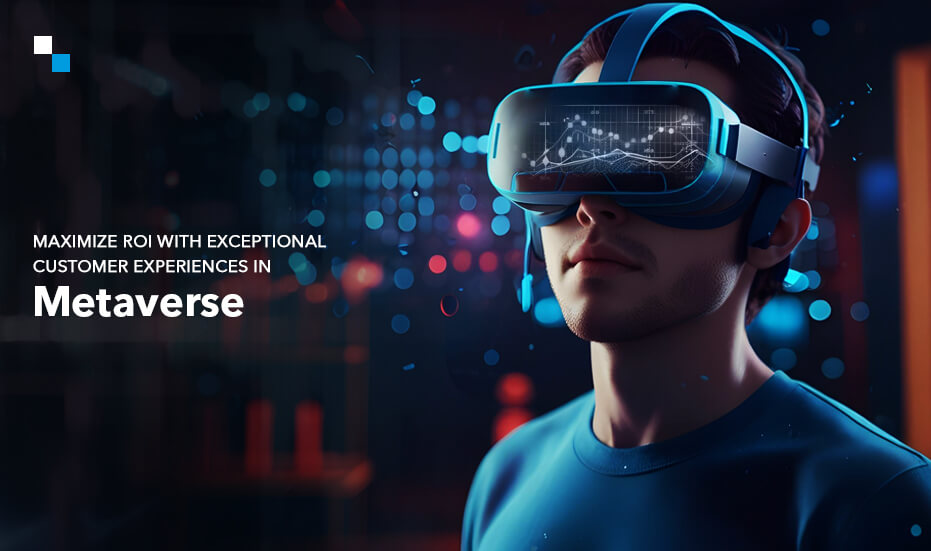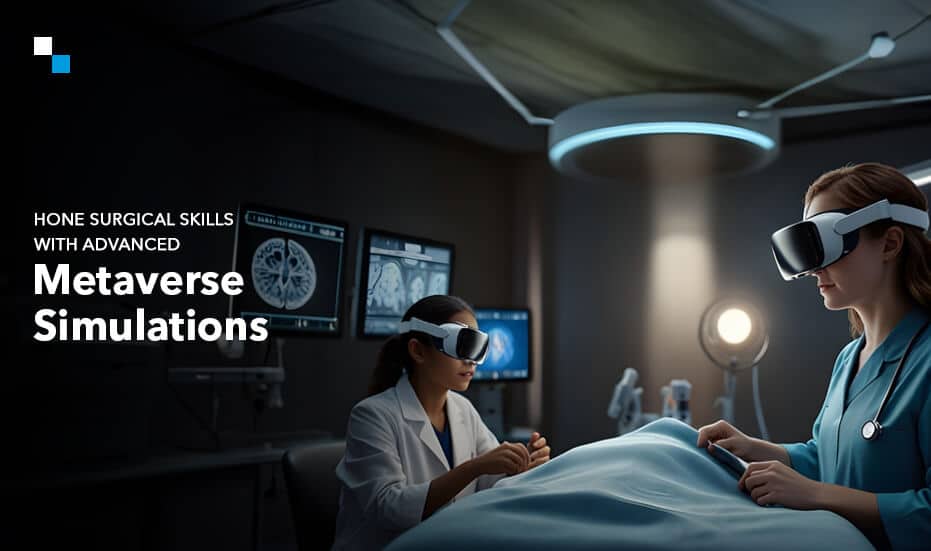
Blockchain & AI: Top Use Cases and Barriers to AI Adoption
August 23, 2023
How is Metaverse Casino Development Changing the Future of Gambling?
August 25, 2023Human beings have always been interested in decoding the secrets of space. We have looked up at the stars and wondered what lies beyond our atmosphere. We try to explore space because of our curiosity, sending probes to the moon, astronauts into orbit, and more. We are eager to see what the future holds as we continue to learn more about the universe.
Space is currently a $365–$424 billion industry. According to thorough research by Citigroup, it is expected to be worth over $2 trillion by 2040. Despite advancements in space technology, it’s challenging for ordinary human beings and scientists to explore the universe.
We have already reached the Moon and have also set up an International Space Station from where we can explore the solar system, but it’s too costly and a risky deal for all countries to conduct space missions with manned crew. As humanity continues to gaze skyward with curiosity and wonder, the concept of space exploration simulations has taken a quantum leap into the digital realm.
In this scenario, metaverse development helps to create an expansive virtual reality landscape. Tech giants can tie up with a trusted metaverse application development company to create a dynamic platform for fostering a deeper understanding of the cosmos.
Exploring the Universe Virtually with the Metaverse
A new level for space travel that surpasses the physical limitations of our world is provided by the metaverse, a virtual universe of immersive experiences.
Let’s explore this interesting nexus of metaverse development in greater detail, highlighting the revolutionary potential it holds for science instruction, astronaut training, and igniting the next generation of space enthusiasts.
1. Unveil Celestial Wonders in the Virtual Frontier
Space exploration without the need for rockets or spacesuits has been made possible with the help of metaverse technology. thanks to complex virtual landscapes that enable space explorers to navigate the stars, planets, and galaxies with unrivaled ease. Think of directing a spaceship through Jupiter’s spinning storms or standing on Mars’ surface and admiring the fine intricacies of its reddish environment.
These meticulously created virtual environments use cutting-edge technology to offer an immersive experience that brings the cosmos closer than ever. Metaverse-based space exploration offers a portal into the unknown that captures the imagination of both amateurs and specialists thanks to realistic images, precise astronomical data, and interactive aspects.
Here are some specific examples of how metaverse development can be used to explore space:
- A user could use a VR headset to explore the surface of the Moon or Mars, without facing the risks of space travel.
- A group of scientists may gather in the metaverse to collaborate on a project to design a new space telescope.
- A Metaverse application development company can create an immersive game that allows players to explore different galaxies and planets.
2. Redefine Astronomical Education
Education is one of the areas where space exploration through metaverse development has had the most profound effects. Traditionally, textbooks and graphics have been used to teach astronomy. It can be the best way of imparting knowledge, yet it can fall short of capturing the vastness and complexity of the cosmos.
Students no longer rely solely on static images to grasp complex celestial phenomena. Instead, they can embark on simulated excursions across space, discovering far-off galaxies, observing the formation and destruction of stars, and even getting a front-row view of cosmic collisions with the help of technological advancements.
Imagine standing on the surface of a virtual alien planet, gazing up at a sky adorned with unfamiliar constellations. Students may manipulate celestial objects, alter time, and watch the planets’ complex dance as they revolve around the sun with just a single motion.
Through their ability to engage with the universe in previously unthinkable ways, students are able to get a greater comprehension of astronomical ideas through these dynamic and adaptable metaverse encounters.
Simulations that use the metaverse also bring abstract ideas to life. Students can travel across the Milky Way to investigate its spiral arms, observe the warping of spacetime around a black hole, and gain an understanding of the size of our solar system.
These simulations give users a concrete feeling of scale and perspective, which helps them grasp the vastness of the cosmos.

3. Provide Astronaut Training in Virtual Space
Being an astronaut has always been a challenging and physically taxing profession.
Experiences are more important than merely gaining theoretical knowledge. A Metaverse application development company can simplify astronaut training. A new age of astronaut training has begun with the emergence of the metaverse. Virtual reality is used by developers to train astronauts for the difficulties of deep space travel.
Metaverse development has brought space training out of the confines of textbooks by building massive simulation centers and allowing learners to peep into the virtual realm. Imagine a future astronaut donning a sleek VR headset and instantly finding themselves floating in the vacuum of space, surrounded by a breathtaking panorama of stars. Astronaut training through the metaverse can be a life-changing experience that combines technology, realism, and education.
Virtual space training offers a multitude of benefits. First of all, it enables students to spend time in a setting that closely resembles the conditions of space, including the delicate balance of spaceship controls and the weightlessness of microgravity.
Aspiring astronauts can practice a variety of abilities, from carrying out extravehicular activities (EVAs) to precisely guiding spacecraft, thanks to this level of realism.
The virtual environment provides a platform for practicing difficult activities, honing skills, and even mimicking emergency situations without the inherent dangers of real-world training.
The metaverse also makes astronaut training cost-effective and convenient.
In the past, only a small group of people with the means and chance could go through the challenging process of preparing for space missions.
The metaverse also makes astronaut training accessible and convenient. No matter where they are physically located, aspiring astronauts from a variety of backgrounds can get the same degree of immersion training. It widens the pool of possible space explorers.
As the metaverse development expertise is reaching new heights, simulators used for astronaut training will become more sophisticated in the times to come. There is tremendous potential for cooperative training activities within the metaverse. Future astronauts could take part in cooperative virtual missions, train for interstellar navigation with international colleagues, and exchange knowledge on how to operate in the particular difficulties of space environments.
4. Provide Easy Access To People For Space Exploration
Human imagination has long been intrigued by space. With the emergence of metaverse development, the boundaries of space exploration are expanding. It has created an entranceway to the cosmos that is open to everyone.
Metaverse enables people from all walks of life to go on virtual travels and leave the constraints of Earth. You no longer have to stay limited by financial constraints or physical restrictions. An aspiring astronaut or curious enthusiast can now step into immersive digital environments that mirror the far reaches of the universe. With the help of sophisticated simulations, anybody can explore the surfaces of far-off planets, observe cosmic events, and feel the excitement of interplanetary travel from the comfort of their own homes.
This accessibility has the power to transform and enthuse a new generation of space enthusiasts. Imagine a student in a remote village, donning a virtual reality headset and walking on the moon, or a curious mind exploring the rings of Saturn without ever leaving their town. Metaverse development fills the gap between aspiration and reality, sparking curiosity and cultivating a greater love of the cosmos.
Additionally, this strategy transforms education. Traditional astronomy instruction is frequently abstract and difficult to understand. However, metaverse-based space exploration turns abstract ideas into concrete experiences. Students can experience cosmic events, interact with simulated celestial bodies, and develop a visceral grasp of how the universe functions. Along with fostering a love of science, this experiential learning also builds critical thinking and a feeling of wonder.
5. Simplify Collaborative Cosmic Endeavors
Collaborative cosmic activities are taking shape in this new metaverse period, transcending boundaries of space and time and connecting fields of study in previously inconceivable ways. The convergence of metaverse development and space exploration helps to create a revolutionary platform where scientists, researchers, educators, and fans from around the world may collaborate to solve the universe’s secrets.
A world of shared experiences is made possible by the metaverse, allowing people to connect, communicate, and work together in real-time. The field of space exploration has been given fresh life and has been propelled into a domain of collaborative discovery as a result of this intrinsic nature of interconnection.
Globally famous space researchers are often separated by vast distances. They can now come together in virtual environments to analyze intricate astronomical data, recreate celestial events, and carry out experiments that go beyond what is possible in conventional laboratories. Researchers and space scientists can work together in a laboratory created by a Metaverse application development company to solve the mysteries of the cosmos. This laboratory can open the doors to a limitless number of possibilities.
The metaverse’s collaborative environment sparks innovative ideas and novel approaches to space exploration. Engineers from different continents can collectively design and refine spacecraft components, while astrophysicists can collaboratively model complex astrophysical processes. The metaverse develops into a breeding environment for creativity, where various viewpoints merge to advance the frontiers of knowledge.
The most crucial aspect of metaverse development is that it starkly democratizes cosmic exploration. In the past, only institutes with substantial funding were able to conduct experiments. Today, space enthusiasts from all walks of life may now actively participate in cutting-edge research and give back to space missions while remaining in the comfort of their own homes. This openness generates not just a sense of a worldwide community bound by a common interest in the cosmos but also speeds up scientific advancement.
Conclusion
The conjugation of the metaverse and space technology has brought a big change in the ways we gaze at the stars and imagine space. We now have the chance to investigate the universe in ways that were previously only possible in science fiction. The metaverse is shown to be more than simply a blank canvas for creative expression as we explore the digital frontier; it also serves as a portal to the stars.
Space exploration through the metaverse development is influencing a future in which the universe is accessible to everyone who dares to explore, whether it be motivating the next generation of astronomers, reinventing astronaut training, or fostering global collaboration.
Antier, a Metaverse application development company, is a space simulation pioneer, providing a virtual portal to investigate galaxies, planets, and cosmic events. We combine technology with the universe to pique curiosity and awaken the inner star in you. Contact us now!



